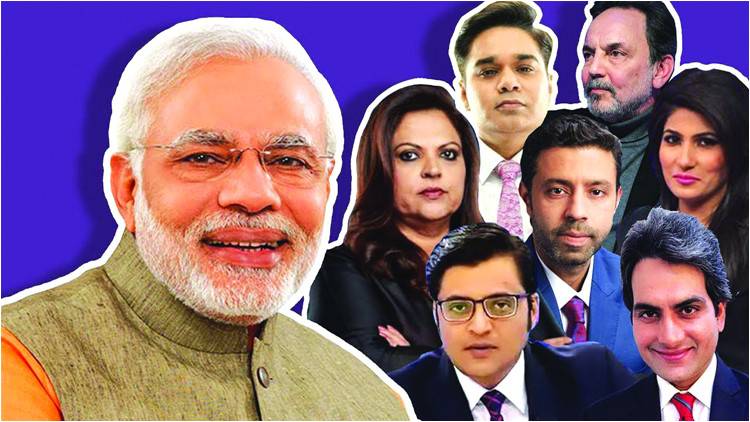
It is not a complaint but rather a reflection on the general state of play: in my 50 years of journalism, Narendra Modi happens to be the only prime minister I have never met. Whenever I tried meeting him years ago I was directed to Vinay Sahasbudhe of the RSS. In his very polite way he was able to transmit the message: meetings with Modi were not going to be the order.
New Delhi, once the world’s favourite haunts for journalistic banter, could now be among the world’s least informed capitals. News-wise, Mumbai, Kolkata, Chennai, Lucknow became livelier. In the absence of information, anchors and journalists fell back on the tedium of speculating on the outcome of this by-election, that state election, gathbandhan or Mahagathbandhan, caste or communal and so on.
For the unending war, now in its 18th year in Afghanistan, show me one discussion on the electronic media. Or, for that matter, in print. Wait patiently until the Indian Express reproduces the main editorial of The Economist explaining the state of play in what is our backyard.
Afghanistan is not an exception. The once Hindu Kingdom of Nepal has been explained to us by BBC, CNN, New York Times, Reuters. The vibrant arenas for cockfights which pass for our news channels have no bureaus in Afghanistan, Nepal, Bangladesh, Maldives, Sri Lanka, Myanmar, China, Russia, the UK or even US. Just one formula:
Udhar raqeeb idhar hum bulay jaatey hain
Ki daana daal ke murghe laraye jaatey hain
(Me from this side, rival from the other
Toss some corn, and there begins the cockfight)
The prime minister, in his very first speech in the Lok Sabha in May, 2014, had talked of ridding the country of “ghulami” or intellectual servitude. If the prime minister is as good as his word, he should immediately take note of this monopoly of the foreign media. Gandhi was all for windows to be kept open so that influences from all sides can enter – and depart. The prime minister swears by nationalism; I call it self-esteem. Both are bruised if India’s ruling elite is captive to Anglo-American media only, in the coverage of international affairs.
Despite the fact that Russia, China and Iran are not liberal democracies, all three have a large number of bureaus across the globe. They make effective interventions whenever the Western media slants the story against them. In the 2019 elections the world media went to town against ‘the Divider in Chief.’ Did Modi’s cohorts ever think of challenging the affront? If they tried to, they would discover that the world’s largest democracy does not have the means to reach audiences beyond its shores.
Modi’s experience with the media is limited. In his earliest stages, his exposure was to a hostile media which implicated him in the Gujarat pogrom of 2002. Later, his core team with inputs from such groups as APCO, an international consultant, helped build brand Modi which did not need the media in its normal newsgathering and column writing avatar. The process of branding did not require him to dwell on the economy, which he knew was in a shambles. He was advised by his marketers to dwell on an “intangible” theme, which had emotive power. Pakistan was amplified as a hate object and publicly flogged at Balakot; Modi’s rhetoric served as the accompanying sound effect. “Ghar mein ghus ke mara” or “bash him in his house” is the language of gangsters but then even Robin Hood was an adorable outlaw.
Does Modi need the media at all? Of course he does. The Modi project would be stillborn without the media, but he needs a captive media, not a critical, independent one.
This entails a two-tier media policy. Modi will be exempt from media interrogation. He will make appearances calculated by his core team only to enhance his charisma and serve some critical purpose.
Where interaction with the media will be essential, say, the Ministry of External Affairs, then it would be done. Otherwise unfiltered material will saturate the alternative space. Moreover, being on talking terms with the media enhances a general sense of ventilation. Let me give an example of a seemingly innocuous story which served the national purpose in an unexpected way.
A Joint Secretary from the MEA – my Deep Throat - working with Prime Minister Morarji Desai’s team accosted me outside his office and invited me to his room for coffee. His princely friends from Jaisalmer and Barmer had sent him photographs (which he showed me) of private jets from Saudi Arabia, Qatar and the UAE landing at air force runways. These luxury aircraft were lined with scores of hooded falcons and equipment for palatial tents to be erected in the desert.
The Shaikhs of Araby had identified the desert around Jaisalmer and Barmer as the world’s finest hunting ground for the Great Indian Bustard, the most handsome of birds. Environmentalists had seen a sharp drop in the bustard population. If falconry was not discontinued the bird would be extinct. Deep Throat managed to obtain written orders to the district authorities in Rajasthan. The story appeared on page one. A senior MEA official travelled all the way to the Shaikh’s luxurious hunting ground. They were requested to pack up their tents. I had not realised the story would spread like forest fire. It gathered momentum as a national campaign. The Great Indian Bustard was saved and all because of one conscientious objector. All nature lovers owe him a word of thanks. Just as the Deep Throat of Watergate was eventually revealed, I think there is no harm in revealing the saviour of the Great Indian Bustard. He is an ailing man today. In fact, quite ironically, Deep Throat has lost his voice. His name is Vinod Grover, once our ambassador to Ankara, The Hague and Nairobi.
The writer is a journalist based in India
New Delhi, once the world’s favourite haunts for journalistic banter, could now be among the world’s least informed capitals. News-wise, Mumbai, Kolkata, Chennai, Lucknow became livelier. In the absence of information, anchors and journalists fell back on the tedium of speculating on the outcome of this by-election, that state election, gathbandhan or Mahagathbandhan, caste or communal and so on.
For the unending war, now in its 18th year in Afghanistan, show me one discussion on the electronic media. Or, for that matter, in print. Wait patiently until the Indian Express reproduces the main editorial of The Economist explaining the state of play in what is our backyard.
New Delhi, once the world’s favourite haunts for journalistic banter, could now be among the world’s least informed capitals. News-wise, Mumbai, Kolkata, Chennai, Lucknow became livelier
Afghanistan is not an exception. The once Hindu Kingdom of Nepal has been explained to us by BBC, CNN, New York Times, Reuters. The vibrant arenas for cockfights which pass for our news channels have no bureaus in Afghanistan, Nepal, Bangladesh, Maldives, Sri Lanka, Myanmar, China, Russia, the UK or even US. Just one formula:
Udhar raqeeb idhar hum bulay jaatey hain
Ki daana daal ke murghe laraye jaatey hain
(Me from this side, rival from the other
Toss some corn, and there begins the cockfight)
The prime minister, in his very first speech in the Lok Sabha in May, 2014, had talked of ridding the country of “ghulami” or intellectual servitude. If the prime minister is as good as his word, he should immediately take note of this monopoly of the foreign media. Gandhi was all for windows to be kept open so that influences from all sides can enter – and depart. The prime minister swears by nationalism; I call it self-esteem. Both are bruised if India’s ruling elite is captive to Anglo-American media only, in the coverage of international affairs.
Despite the fact that Russia, China and Iran are not liberal democracies, all three have a large number of bureaus across the globe. They make effective interventions whenever the Western media slants the story against them. In the 2019 elections the world media went to town against ‘the Divider in Chief.’ Did Modi’s cohorts ever think of challenging the affront? If they tried to, they would discover that the world’s largest democracy does not have the means to reach audiences beyond its shores.
Modi’s experience with the media is limited. In his earliest stages, his exposure was to a hostile media which implicated him in the Gujarat pogrom of 2002. Later, his core team with inputs from such groups as APCO, an international consultant, helped build brand Modi which did not need the media in its normal newsgathering and column writing avatar. The process of branding did not require him to dwell on the economy, which he knew was in a shambles. He was advised by his marketers to dwell on an “intangible” theme, which had emotive power. Pakistan was amplified as a hate object and publicly flogged at Balakot; Modi’s rhetoric served as the accompanying sound effect. “Ghar mein ghus ke mara” or “bash him in his house” is the language of gangsters but then even Robin Hood was an adorable outlaw.
Does Modi need the media at all? Of course he does. The Modi project would be stillborn without the media, but he needs a captive media, not a critical, independent one.
This entails a two-tier media policy. Modi will be exempt from media interrogation. He will make appearances calculated by his core team only to enhance his charisma and serve some critical purpose.
Where interaction with the media will be essential, say, the Ministry of External Affairs, then it would be done. Otherwise unfiltered material will saturate the alternative space. Moreover, being on talking terms with the media enhances a general sense of ventilation. Let me give an example of a seemingly innocuous story which served the national purpose in an unexpected way.
A Joint Secretary from the MEA – my Deep Throat - working with Prime Minister Morarji Desai’s team accosted me outside his office and invited me to his room for coffee. His princely friends from Jaisalmer and Barmer had sent him photographs (which he showed me) of private jets from Saudi Arabia, Qatar and the UAE landing at air force runways. These luxury aircraft were lined with scores of hooded falcons and equipment for palatial tents to be erected in the desert.
The Shaikhs of Araby had identified the desert around Jaisalmer and Barmer as the world’s finest hunting ground for the Great Indian Bustard, the most handsome of birds. Environmentalists had seen a sharp drop in the bustard population. If falconry was not discontinued the bird would be extinct. Deep Throat managed to obtain written orders to the district authorities in Rajasthan. The story appeared on page one. A senior MEA official travelled all the way to the Shaikh’s luxurious hunting ground. They were requested to pack up their tents. I had not realised the story would spread like forest fire. It gathered momentum as a national campaign. The Great Indian Bustard was saved and all because of one conscientious objector. All nature lovers owe him a word of thanks. Just as the Deep Throat of Watergate was eventually revealed, I think there is no harm in revealing the saviour of the Great Indian Bustard. He is an ailing man today. In fact, quite ironically, Deep Throat has lost his voice. His name is Vinod Grover, once our ambassador to Ankara, The Hague and Nairobi.
The writer is a journalist based in India

